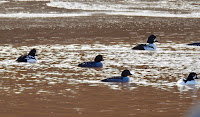BARROW'S GOLDENEYE
BARROW’S GOLDENEYE – (Bucephala islandica) – (See images below)
DESCRIPTION: The Barrow’s Goldeneye is a diving duck. The adult male has a dark purplish head, black tops and white under parts. The bill is black and has a white crescent patch at the base. The legs and feet are orange. The female has a dark reddish-brown head and a bright orange bill. The eyes are yellow (hence the name). This duck measures around 45 cm (17 inches) long.
VOICE: https://www.xeno-canto.org/species/Bucephala-islandica
NAME: The English name ‘Duck’ is from Anglo-Saxon ‘duce’ and means ‘diver’. The bird is named after John Barrow, an English stateman in the 1700-1800s who travelled extensively. The Latin genus name refers to the shape of the head, a ‘bull’s head’. As for the Latin species name ‘islandica’, it refers to Iceland, where it breeds.
HABITAT: Alkaline and fishless lakes in northwest Canada and USA.
DIET: Molluscs, aquatic insects and crustaceans.
NESTING: The nest is built in a tree cavity or a nest box (if available). Around seven to eleven light blue-green eggs are laid, incubated by the female. Sometimes the ducklings form creches.
DISTRIBUTION: Breeding range includes western Canada, Alaska and parts of western USA. There’s also a small breeding population of this bird in Eastern Canada and Iceland. It winters along the western and eastern coasts of North America.
DISTRIBUTION MAP: https://en.wikipedia.org/wiki/Barrow%27s_goldeneye#/media/File:Bucephala_islandica_map.svg
ON PEI: The Barrow’s goldeneye does not breed on Prince Edward Island, but it is fairly common in all seasons on the island except summer.
CONSERVATION: Based on COSEWIC’s research, the Barrow’s Goldeneye is a species of ‘special concern’ for its eastern population, and Environment Canada has a management plan for it : Barrow’s Goldeneye Management Plan – Govt of Canada (.pdf file). Threats include deforestation and stocking lakes with fish, notably brook trout. This duck prefers fishless lakes for hunting its prey. It is protected from hunting. Mature tree forests are vital to its survival because of its nesting habits. The Barrow’s goldeneye population was also deeply impacted by the Exxon Valdez oil spill in 1989 in Prince William Sound, Alaska, as it contaminated its winter feeding grounds along the coast.
SIMILAR SPECIES: Bufflehead, Common Goldeneye (here’s an article by the Government of Canada to help hunters distinguish this duck from the threatened Barrow’s Goldeneye).
REFERENCES: https://en.wikipedia.org/wiki/Barrow%27s_goldeneye
https://www.borealbirds.org/bird/barrows-goldeneye
http://identify.whatbird.com/obj/401/_/Barrows_Goldeneye.aspx
http://www.birdweb.org/birdweb/bird/barrows_goldeneye
https://www.allaboutbirds.org/guide/Barrows_Goldeneye/id
http://www.ducks.org/hunting/waterfowl-id/barrows-goldeneye
https://www.naturenb.ca/2020/01/16/barrows-goldeneye-survey-2020/
DESCRIPTION: The Barrow’s Goldeneye is a diving duck. The adult male has a dark purplish head, black tops and white under parts. The bill is black and has a white crescent patch at the base. The legs and feet are orange. The female has a dark reddish-brown head and a bright orange bill. The eyes are yellow (hence the name). This duck measures around 45 cm (17 inches) long.
VOICE: https://www.xeno-canto.org/species/Bucephala-islandica
NAME: The English name ‘Duck’ is from Anglo-Saxon ‘duce’ and means ‘diver’. The bird is named after John Barrow, an English stateman in the 1700-1800s who travelled extensively. The Latin genus name refers to the shape of the head, a ‘bull’s head’. As for the Latin species name ‘islandica’, it refers to Iceland, where it breeds.
HABITAT: Alkaline and fishless lakes in northwest Canada and USA.
DIET: Molluscs, aquatic insects and crustaceans.
NESTING: The nest is built in a tree cavity or a nest box (if available). Around seven to eleven light blue-green eggs are laid, incubated by the female. Sometimes the ducklings form creches.
DISTRIBUTION: Breeding range includes western Canada, Alaska and parts of western USA. There’s also a small breeding population of this bird in Eastern Canada and Iceland. It winters along the western and eastern coasts of North America.
DISTRIBUTION MAP: https://en.wikipedia.org/wiki/Barrow%27s_goldeneye#/media/File:Bucephala_islandica_map.svg
ON PEI: The Barrow’s goldeneye does not breed on Prince Edward Island, but it is fairly common in all seasons on the island except summer.
CONSERVATION: Based on COSEWIC’s research, the Barrow’s Goldeneye is a species of ‘special concern’ for its eastern population, and Environment Canada has a management plan for it : Barrow’s Goldeneye Management Plan – Govt of Canada (.pdf file). Threats include deforestation and stocking lakes with fish, notably brook trout. This duck prefers fishless lakes for hunting its prey. It is protected from hunting. Mature tree forests are vital to its survival because of its nesting habits. The Barrow’s goldeneye population was also deeply impacted by the Exxon Valdez oil spill in 1989 in Prince William Sound, Alaska, as it contaminated its winter feeding grounds along the coast.
SIMILAR SPECIES: Bufflehead, Common Goldeneye (here’s an article by the Government of Canada to help hunters distinguish this duck from the threatened Barrow’s Goldeneye).
REFERENCES: https://en.wikipedia.org/wiki/Barrow%27s_goldeneye
https://www.borealbirds.org/bird/barrows-goldeneye
http://identify.whatbird.com/obj/401/_/Barrows_Goldeneye.aspx
http://www.birdweb.org/birdweb/bird/barrows_goldeneye
https://www.allaboutbirds.org/guide/Barrows_Goldeneye/id
http://www.ducks.org/hunting/waterfowl-id/barrows-goldeneye
https://www.naturenb.ca/2020/01/16/barrows-goldeneye-survey-2020/
 |
| Barrow's goldeneyes, PEI, Marie Smith |
 |
| Barrow's goldeneyes, PEI, Marie Smith |
 |
| Barrow's goldeneye drake, PEI, by Roberta Palmer |
 | |
| Barrow's goldeneye female Donna Dewhurst, USFWS |